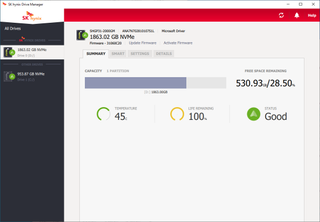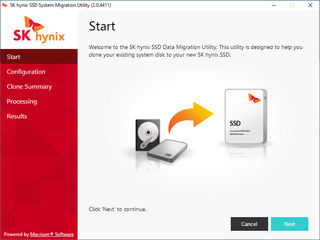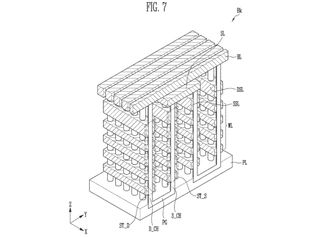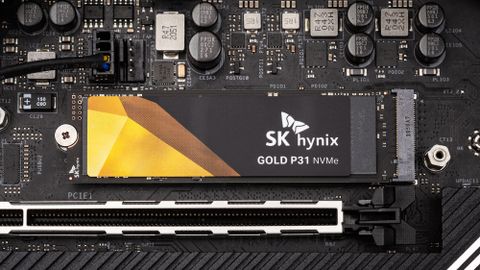Tom's Hardware Verdict
The SK hynix 2TB Gold P31 flaunts very high performance for its price point and comes with an SSD toolbox and a black PCB (on the 2TB model only) for a more appealing aesthetic.
Pros
- +
+ Class-leading power efficiency
- +
+ Top-tier performance
- +
+ Competitive endurance & 5-year warranty
- +
+ Single sided-form factor
- +
+ Low cost
- +
+ AES 256-bit encryption
Cons
- -
The 2TB model is a little slower than the 1TB model
- -
Black PCB only for 2TB capacity
Why you can trust Tom's Hardware
Update 2 - September 26, 2021: This review has been updated with new testing for the 2TB SK hynix Gold P31 M.2 NVMe on page 4.
Update 1 - October 3, 2020: We have updated this article with new testing for the 500GB SK hynix Gold P31 M.2 NVMe on page 2.
Original Review published on September 4, 2020:
SK hynix’s Gold P31 is the first retail M.2 NVMe SSD from the company as well as the first product to hit the market leveraging the company’s sixth-generation 128-Layer ‘4D’ TLC NAND flash. Like the Gold S31 SATA SSD, the Gold P31 M.2 NVMe SSD leaves us with quite a positive first impression, touting killer performance with the best efficiency scores that we have seen yet. It competes with the best SSDs, and at prices of just $0.13-0.15 per GB, it screams value. But being that it is a first, there are teething issues such as an unsightly green PCB.
SK hynix’s Gold P31 is packed with the company’s 4D NAND flash, which while it may sound like a new type of memory, is actually a bit less complex than that. It's SK hynix’s marketing talk for how the company arranges the memory control circuits, known as the peripheral circuitry, in relation to the NAND cell arrays on this 128L 4D TLC flash.
Traditionally, the peripheral circuitry logic lays on the edge of the NAND cell array, potentially taking up to 40% of the die space and thus limiting scalability. By moving the logic under the array, manufacturers can achieve higher-layer designs while retaining a high array efficiency. The concept of placing the peripheral circuitry under the memory cells (PuC) isn’t new. As a matter of fact, this technology is currently implemented on Intel and Micron’s NAND flash in the form of CMOS under Array (CuA) technology.
| SK hynix 4D NAND | Samsung V5 V-NAND | Kioxia BiCS4 | Micron | |
|---|---|---|---|---|
| Bit count per cell | 3-bit / TLC | 3-bit / TLC | 3-bit / TLC | 3-bit / TLC |
| Data layer count | 128 | 92 | 96 | 96 |
| Total layer count | 147 | 100 | 109 | 106 |
| Cell array efficiency | 87.10% | 92.00% | 88.10% | 90.60% |
| Die density (Gb) | 512 | 512 | 512 | 512 |
| Die area (mm^2) | 63.2 | ? | 86.0 | 81.8 |
| Bit density (Gb/mm^2) | 8.1 | ? | 6.0 | 6.3 |
By combining CuA with a floating gate cell design, Micron’s flash achieved some of the highest bit density going, 6.25 Gb/mm^2 on 512Gb 96L TLC, that is, before SK hynix’s latest 128L 4D NAND dropped. What sets SK hynix’s 4D NAND apart is that instead, the company combined PuC technology with a 3D charge trap flash (CTF) cell design to achieve a very small die size and high die density of 8.1 Gb/mm^2. The CTF cells tend to be smaller compared to floating gate cells and the overall design offers better scaling capability as the layer count grows.
SK hynix Gold P31 Specifications
| Product | 500GB | 1TB | 2TB |
|---|---|---|---|
| Pricing | $74.99 | $134.99 | $279.99 |
| Capacity (User / Raw) | 500GB / 512GB | 1000GB / 1024GB | 1000GB / 1024GB |
| Form Factor | M.2 2280 S3 | M.2 2280 S3 | M.2 2280 S3 |
| Interface / Protocol | PCIe 3.0 x4 / NVMe 1.3 | PCIe 3.0 x4 / NVMe 1.3 | PCIe 3.0 x4 / NVMe 1.3 |
| Controller | SK hynix Cepheus | SK hynix Cepheus | SK hynix Cepheus |
| DRAM | LPDDR4 | LPDDR4 | LPDDR4 |
| Memory | SK hynix 128L TLC | SK hynix 128L TLC | SK hynix 128L TLC |
| Sequential Read | 3,500 MBps | 3,500 MBps | 3,500 MBps |
| Sequential Write | 3,100 MBps | 3,200 MBps | 3,200 MBps |
| Random Read | 570,000 IOPS | 570,000 IOPS | 570,000 IOPS |
| Random Write | 600,000 IOPS | 600,000 IOPS | 600,000 IOPS |
| Security | AES 256-bit encryption | AES 256-bit encryption | AES 256-bit encryption |
| Endurance (TBW) | 500 TB | 750 TB | 1,200 TB |
| Part Number | SHGP31-500GM-2 | SHGP31-1000GM-2 | SHGP31-2000GM-2 |
| Warranty | 5-Years | 5-Years | 5-Years |
SK hynix Gold P31 Features
SK hynix’s Gold P31 comes in 500GB, 1TB, and 2TB capacities and carries very low pricing, listing for as low as $75, $135, and $280, respectively. The Gold P31 delivers up to 3.5/3.2 GBps read/write speed at 1TB and 2TB, though the 500GB model suffers a 100MBps lower write speed. The SSD’s random read and write performance is similar at all capacities, too, with up to 570,000/600,000 random read/write IOPS.
While pushing out fast read performance is rather easy for flash, high write performance requires a few tricks. SK hynix’s Gold P31 utilizes a hybrid SLC cache, similar to Samsung’s TurboWrite. It features a quickly-recovering SLC cache alongside a slower-to-recover dynamic SLC cache. The 500GB’s total cache capacity measures 46GB, the 1TB model comes with roughly 92GB, and the 2TB model has 184GB.
The 500GB drive can endure up to 500TB of writes, the 1TB drive up to 750TB of writes, and the 2TB model can absorb up to 1,200TB of writes within its five-year warranty.
With the help of Low-Density Parity-Check (LDPC) ECC, SK hynix’s Gold P31 comes backed with respectable endurance numbers that exceed Samsung’s 970 EVO Plus, WD’s Black SN750, and Crucial’s P5. However, while these figures seem impressive, they can’t hold a candle to the exceptional endurance ratings provided by Phison-powered SSDs like the Seagate FireCuda 510 or Team Group Cardea Zero Z340 that are have more than twice the endurance at the 1TB capacity point.
SK hynix’s Gold P31 features S.M.A.R.T. data reporting, secure erase capability, Trim support, can fall into multiple low power states, and even comes with support for AES 256-bit hardware encryption. However, it isn’t OPAL complaint, meaning there’s no BitLocker support.
Software and Accessories of SK hynix Gold P31

SK hynix supports the Gold P31 with a basic SSD toolbox and cloning software. The SK hynix Drive Manager allows you to view the P31’s S.M.A.R.T. data and update the firmware if needed. Designed in partnership with Macrium, SK hynix’s SSD System Migration Utility enables you to clone your data from your old drive to your new SK hynix SSD.

A Closer Look at SK hynix Gold P31


SK hynix’s Gold P31 comes in an M.2 2280 single-sided form factor so it is compatible with even the slimmest of Ultrabooks. The Gold P31’s clean black and gold label pops when you look at it. However, as quickly as it catches your attention, the green PCB begins to become an unattractive distraction. While the Gold P31 gains style points for the hidden SKU markings and other compliance marks, it loses some for the green PCB.
The company wouldn’t disclose the process node used, core count, or frequency details on the controller, but detailed to us that SK hynix’s Gold P31 is vertically integrated and that all its major components are built by SK hynix. The Gold P31 is powered by the company’s Arm-based multi-core, 4-channel ‘Cepheus’ PCIe 3.0 x4 NVMe 1.3 controller. It measures 14 x 14mm and features a DRAM-based architecture.
The Cepheus SSD controller interfaces with DRAM to cache the FTL mapping table information, which ensures responsive and consistent performance. The company included an LPDDR4 2,133 MHz DRAM chip that measures 4Gb (512MB) in density on the 500GB model and 8Gb (1GB) in density on our 1TB model.


At first glance, the fact that the controller has just half of the number of channels of most high-end NVMe SSDs makes it seem like it could be very underpowered for an SSD that is supposed to compete with the best of WD, Samsung, and Crucial, as well as SSDs based on Silicon Motion and Phison controllers. That is if it wasn’t for the high IO rate that SK hynix’s 128L TLC NAND flash operates at.
SK hynix’s Gold P31 interfaces with the flash die over those four channels at Toggle DDR4.0 I/O rates of 1200 MTps while consuming just 1.2V. This is an important aspect to note because it is roughly double that of what most current-gen NAND runs up to, and in conjunction with the 4-channel controller, both help the Gold P31 deliver some incredible power efficiency. Typically, SSDs based on Kioxia’s 96L or Micron’s 96L operate at much slower I/O rates of 533-800 MTps, with Samsung being the exception. Samsung’s latest V-NAND flash operates at up to 1,400 MTps, although the company’s flash controllers most likely interface at only 1,000-1,200 MTps in current products.

Since the Cepheus controller on the P31 interfaces with the NAND at this higher operating MTps rate, it somewhat helps to make up some performance for the lower channel count. Plus, like with Micron and Intel’s flash, SK hynix’s 4-plane design helps quite a bit with interleaving, too, because that means the controller has four independent sections of NAND die access for increased performance. Kioxia’s 96L BiCS4 and Samsung’s 92L V-NAND flash are only 2-plane designs, although the latter features sub-planes to help make up for it.

Traditionally SK hynix’s flash has used a P-BiCS (Pipe-shaped BiCS) architecture, which is an evolved form of Kioxia’s (formerly Toshiba Memory) BiCS (Bit Cost Scalable) CTF architecture. Its design uses a U-shaped vertical NAND string with the placement of the source line at the top of the stack rather than the bottom. These tweaks, among others, help to both enhance data retention and cell reliability, but also improve cut-off characteristics and provide better cell charge sensing performance.
Furthermore, like Kioxia’s BiCS, SK hynix’s 128L 4D NAND achieves such high layer counts with multiple string stacks (or decks) where groups of data word lines are stacked above one another and commonly with dummy word lines to prevent program disturbs. The issue with this process is that alignment can be tricky and misalignments of the stacks could lower production yield, which is likely why Samsung is trying to avoid this technology for as long as possible. To overcome this issue, SK hynix relies on an ultra-homogeneous vertical etching technology in conjunction with high-reliability multi-layer thin-film cell formation technology.

An early tease from Tech Insights reveals that the NAND on the Gold P31 comes at a die density of 512Gb (64GB per die) and has as many as 147 actual layers with some acting as dummy layers or gates for selection to achieve the 128 data word lines. We believe that this 128L flash could feature a double or triple deck design, but we will have to await Tech Insight’s final analysis. There are four dies per package on the 500GB model, eight in total, as well as 8 dies per package on the 1TB model, for 16 in total.
Current page: Features and Specifications
Next Page 500GB Performance Results for SK hynix Gold P31
Sean is a Contributing Editor at Tom’s Hardware US, covering storage hardware.
-
King_V Some nits to picK pick (because, clearly, I'm more likely to fumble when I'm pointing out someone else's fumbles)Reply
Spec table column headers both say 1TB, the first one should be 500GB (or 512?)
Paragraph below spec table says "though the 500GB model suffers a minimal performance loss with a write speed that is 100MBps lower" but the table shows the 500GB model having a faster sequential write speed. Which one is correct?That aside - I'm definitely intrigued that it's competitive speed-wise, and manages that impressive level of power efficiency. I think this one might be on my list for a future PC. -
seanwebster Thanks, I actually saw that too not too long ago and already alert the team on the errors. The write speeds should be swapped. 3,200 on the 1TB and 3,100 on the 500GB. Correction should go live shortly.Reply -
cknoettg One more possible point of contention.Reply
The article states that the P31 Gold does not support AES-256.
But SK Hynix's own website for the P31 gold states that it does:
https://skhynix.freshdesk.com/support/solutions/folders/48000658600#faq_title
"All SSDs from SK hynix come with the AES 256-bit encryption feature. "
I have seen manufacturer's documentation be wrong, but is there any way to test to see if it does or not? -
seanwebster Reply
Nice find. This wasn't posted nor articulated at the time of publishing. We will update to include this.cknoettg said:One more possible point of contention.
The article states that the P31 Gold does not support AES-256.
But SK Hynix's own website for the P31 gold states that it does:
https://skhynix.freshdesk.com/support/solutions/folders/48000658600#faq_title"All SSDs from SK hynix come with the AES 256-bit encryption feature. "
I have seen manufacturer's documentation be wrong, but is there any way to test to see if it does or not? -
DZIrl And what is benefit for user in using 128 layers SSD? Nothing! Drives even cheaper to produce are not cheaper then any other.Reply
Why then? -
Soaptrail Reply
Thank you.Rogue Leader said:This thread has been reopened due to the article update
Anyone know what changed in the new firmware. I skimmed the article and must have missed it. Also it appears not to affect the 1TB drive since those numbers were not updated. I know the 500GB page was updated but what were the original benchmarks for that drive? -
retrofitit Who cares if it has a green PCB?Reply
I put it in my laptop, put the bottom back on and it is not visible.
The desktop another is going in has no glass panel.
It could have a hot pink PCB or baby poo yellow PCB and I would not care, the efficiency and performance is all that matters. -
retrofitit What I would like to know is are they comparing it to the ADATA SX8200 Pro that was provided as an early reviewer sample or the lower spec version actually being sold retail?Reply
